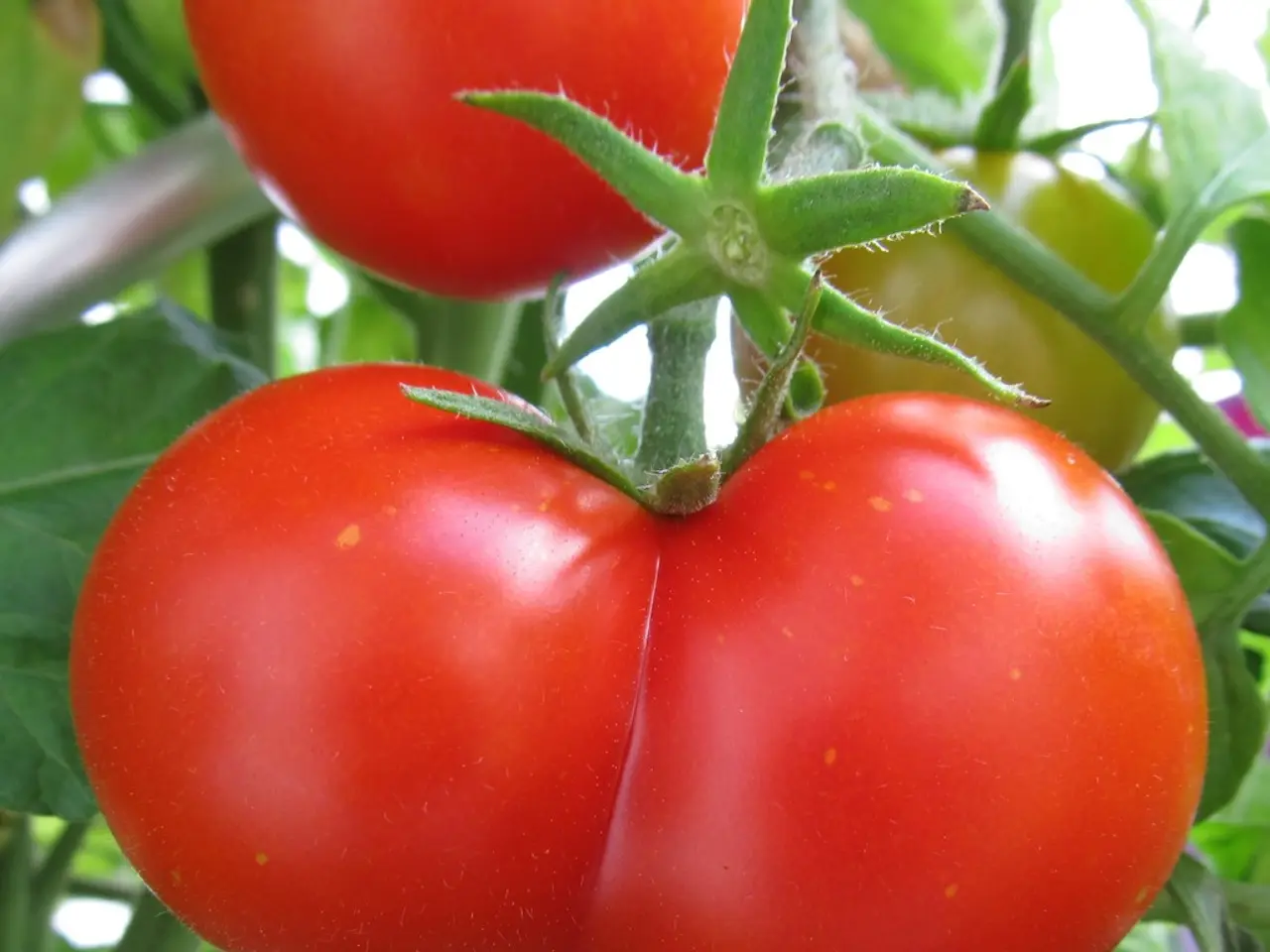Cultivating Tomatoes in a Personal Backyard Garden
Growing and Health Benefits of Tomatoes: A Comprehensive Guide
Tomatoes, the most popular home-grown vegetable in the United States, are not only delicious but also offer numerous health benefits. Here's a roundup of key points for growing and consuming these vibrant fruits.
Growing Tomatoes
- Ohio, well-suited for tomato production, was once ranked second in the nation for processing tomatoes. Tomatoes thrive in a slightly acid soil with a pH of 6.5 to 6.8 and require full sun.
- Before planting, it is a good idea to have the soil tested a year before to determine the soil pH, buffer pH, and nutrient levels. Lime can be added to raise soil pH, while elemental sulfur can be added to lower it.
- Tomatoes are heavy feeders and respond well to fertilizer applications. They need 2 to 3 pounds of a complete fertilizer, such as 6-24-24, 6-12-18, and 8-16-16 per 100 square feet of garden area.
- Container-grown tomato plants require close attention to water and fertilizer needs. Since tomato plants should be watered on a regular basis, it is a good idea to place the garden close to a water source for ease of watering.
- Tomatoes are warm-season plants and should be planted only after danger of frost has passed. They are often categorized as early, mid, or late season in regards to time of ripening.
- Staking tomato plants can be done using two-inch oak stakes or a section of cattle panel fencing. Caging is another popular way to support tomato plants, which are more productive but fruits might ripen later due to heavier fruit load.
- Pruning in staked tomatoes mainly involves the removal of suckers or laterals. Simple pruning is the removal of the entire young sucker at the base near the leaf axile, while Missouri pruning is the removal of the growing tip of the sucker just beyond the first two leaflets.
- Mulching can conserve moisture and suppress weed growth in established tomato plants.
Health Benefits of Tomatoes
- Tomatoes are rich in vitamins C and A, and contain small amounts of the B vitamins and potassium. They are also a great source of lycopene, a powerful antioxidant.
- Lycopene, found in abundance in tomatoes, offers multiple health benefits, including supporting cardiovascular health, boosting immunity, improving fertility, and protecting the skin from damage such as sunburn and potentially skin cancer.
- Lycopene is absorbed better from processed tomato products (like tomato paste, puree, or cooked tomatoes) than from fresh tomatoes because heat processing breaks down the tomato’s cell walls, releasing lycopene and making it more bioavailable to the body. Additionally, processed tomato products have a lower water content, concentrating nutrients including lycopene.
- Furthermore, consuming lycopene-rich tomatoes with dietary fats such as olive oil or avocado significantly enhances lycopene absorption.
This explains why tomato-based sauces, pastes, and cooked tomato dishes are often superior sources of bioavailable lycopene compared to raw tomatoes.
Did you know? - Thomas Jefferson was one of the first to grow tomatoes in the United States, which were called "Love Apples" at the time. - About 80 to 90 percent of lycopene consumed by humans comes from tomatoes. - Disease resistance can be an important consideration when choosing tomato cultivars since most home gardeners are not equipped or willing to spray pesticides on a regular basis to manage diseases.
[1] Agaoglu, M. A., & Kucuk, M. (2012). Lycopene: A potent antioxidant for human health and disease prevention. Antioxidants, 1(1), 1-14.
[2] Rao, A. V., & Elmali, A. (2004). Lycopene and prostate cancer prevention. Nutrition and Cancer, 49(2), 141-149.
[3] Rao, A. V., & Elmali, A. (2004). Lycopene and skin cancer prevention. Nutrition and Cancer, 49(2), 151-158.
[4] Kucuk, M., & Agaoglu, M. A. (2007). Bioavailability of lycopene in human subjects. Critical Reviews in Food Science and Nutrition, 47(7), 643-653.
[5] Rao, A. V., & Elmali, A. (2004). Lycopene and cardiovascular disease prevention. Nutrition and Cancer, 49(2), 131-140.
- To ensure optimal growth, tests can be conducted a year prior to planting to understand the soil pH, nutrient levels, and necessary adjustments using lime or elemental sulfur.
- Horticulture enthusiasts building home-and-garden containers should remember that tomato plants have specific water and fertilizer requirements, with some complete fertilizers like 6-24-24, 6-12-18, and 8-16-16 being suitable.
- In the lifestyle of a dedicated gardener, tomato crops are not only a popular food production venture but also a source of vital nutrients, like vitamins C and A, and lycopene, with its multiple health benefits for cardiovascular health, immunity, fertility, and skin protection.
- For those who prefer food preservation methods, it is interesting to note that processed tomato products, such as tomato paste, puree, or cooked tomatoes, have a higher concentration of bioavailable lycopene compared to fresh tomatoes, particularly when consumed with dietary fats like olive oil or avocado.
- Amidst the array of gardening techniques, choosing tomato cultivars with disease resistance can significantly impact the success and health benefits derived from a home-grown tomato crop, especially for those who prefer organic methods over regular pesticide applications.





